Global and Regional Economic Outlook and the Role of Integration in Asia, speech by Naoyuki Shinohara, IMF Deputy Managing Director
March 27, 2012
IMF Deputy Managing Director
March 27, 2012
As prepared for delivery
Good morning. It is a great pleasure for me to be here today at the prestigious and historic Chulalongkorn University. Yesterday marked the 95th anniversary of this institution which grew out of the vision of King Rama V to strengthen and improve the quality of education and life of Thai people. Today, the alumni of Chulalongkorn University have not only contributed importantly to Thailand but also to many global institutions as well, including to the IMF itself. I am also pleased to be back in Thailand today to witness the strong recovery of the economy and the Thai people from a natural disaster of unprecedented proportions. The flooding in the last quarter of 2011 produced widespread destruction and led to the largest quarter-on-quarter economic decline in recent Thai history. The strong resilience of the population, which was severely affected by the flooding, is impressive. Thai people never seem to lose their smile even under the difficult living conditions they were forced to endure.
Let me say a few words about the global economy before turning to my presentation.
The global economy has gone through very hard times in recent years, and late last year economic indicators pointed to a harsh setback of the global recovery. But in recent weeks, some positive signs have emerged, and financial indicators have stabilized or started to improve, although only modestly, including in the United States. Important policy actions, particularly by European policymakers, have helped. Most recently, the agreement on a new program for Greece—from both the IMF and European partners—has also brought some relief and it will be important to implement all the agreed actions.
Because of all these efforts, the world economy has avoided extremely disruptive outcomes. But there is no room for complacency. A lot more needs to be done to give a fresh boost to growth. The repair of financial systems still has a long way to go. Public debt in many countries remains at all-time highs, constraining policy actions. Unemployment also remains high in many countries. And oil price increases present a real risk to oil importers around the world. In short, we are navigating a very narrow path to full recovery, and the risk of slippage is very high. To stay the course on that narrow path, everyone has a job to do.
• Advanced economies should use macroeconomic policies to support the recovery if they have the space to do so, and should press ahead with financial and structural reforms to repair the damage done by the crisis.
• And emerging economies need to stay vigilant from possible spillovers from the advanced economies while keeping overheating pressures in check where applicable.
• All countries need to make clear efforts to translate higher growth into better living standards for all.
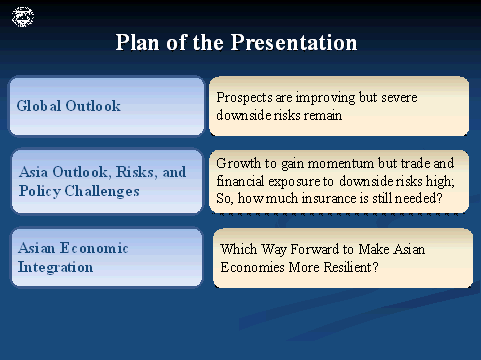
In my talk today, I would like to cover three broad topics. After discussing in a bit more detail the global economic setting, I will focus on the outlook, risks and policy challenges for economies in the Asia-Pacific region. A major near- and medium-term challenge has to do with making Asian economies more resilient to external shocks. So, I would like to also offer views on how progress in regional integration, both in terms of trade and financial integration, can play a role in achieving broader-based and stable growth.
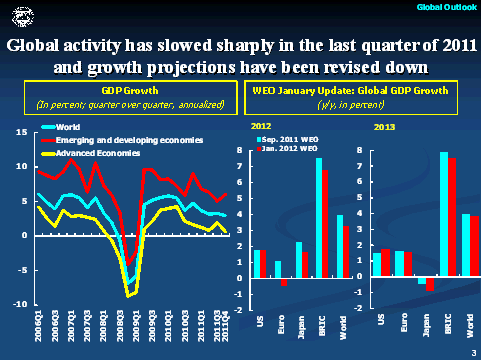
As I hinted before, the global recovery suffered a major setback in late 2011. The future of the EMU became increasingly uncertain, as the sovereign debt crisis sent Italian and Spanish sovereign bond rates to unprecedented levels and business and consumer confidence collapsed. Adverse trade spillovers affected emerging market economies, but specific factors, including policy tightening in emerging Asia and Latin America and social unrest in the Middle East, also took a toll on growth. In the United States, however, credit and labor markets began to show signs of life with consumption and inventory adjustments supporting growth.
Reflecting these developments, our latest projections (published in January) point to global growth slightly above 3 percent in 2012, down from nearly 4 percent in 2011. While we expect growth in the United States, in 2012, to strengthen slightly compared to 2011, the euro area would suffer a mild contraction, as a result of bank deleveraging and tighter lending standards, and fiscal austerity measures. We are in the process of revising our forecast and will publish new numbers in April, but we continue to expect that adverse spillovers from the euro area to other regions will remain limited for as long as the euro area crisis is contained, a key assumption for our baseline projections.
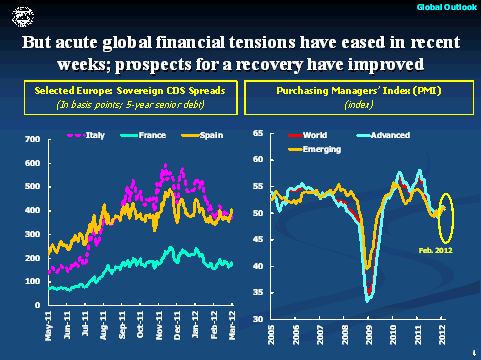
In fact, since the beginning of the year, acute financial tensions in the euro area have eased, in large part thanks to the ECB’s 3-year long-term refinancing operations. The agreement on a euro area fiscal compact also helped lower sovereign risk premia. High frequency economic indicators reflect this improvement: Manufacturing PMI indicators for both advanced and emerging economies have nudged above the expansionary threshold of 50 in recent weeks.
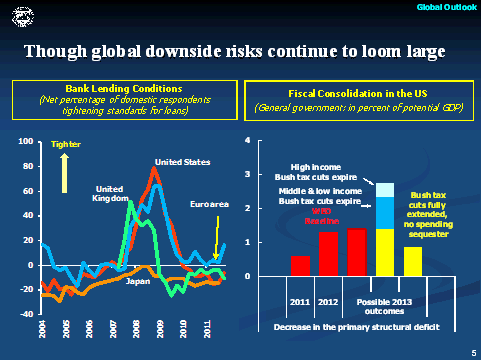
That being said, the recent improvements are very fragile and, with important policy challenges that remain to be addressed, downside risks are large. The most immediate concern is still a further escalation of the euro area crisis that could trigger a much more generalized flight from risk than observed so far. To avoid this risk, European policymakers need to pursue fiscal adjustment at the right pace—and this pace differs across countries; they also need to pursue financial reforms to stabilize the banking sector and structural reforms to restore competitiveness; and they need to increase the strength of their firewall to provide an adequate backstop for the governments undertaking these reforms.
Another concern are political pressures that could stand in the way of sufficiently easy macroeconomic policies. For example, in the United States, we expect fiscal consolidation of about 1¼ percent of GDP in the next fiscal year. But there is a lot of uncertainty around this forecast: it could range from below 1 percent of GDP to about 3 percent of GDP depending on whether the Bush tax cuts, about two-thirds of which were aimed for middle- and low-income earners, are extended and on whether automatic spending cuts are triggered by the failure of the Congressional Committee on deficit reduction.
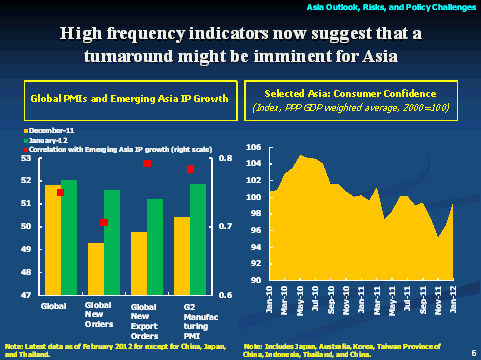
Closer to home, growth in Asia is also expected to regain momentum this year. Activity slowed sharply in the fourth quarter of last year across the region mainly due to weakening external demand. In addition, the Thai floods led to supply chain disruptions which significantly affected production. But domestic demand in emerging Asia has generally remained strong, supported by low unemployment, high capacity utilization, and robust credit growth. In the first months of 2012, leading economic indicators strengthened. Global export orders and manufacturing PMIs in the United States and Europe (G2)—both of which have been highly correlated with industrial production in Asia in the past—have improved substantially, suggesting similar improvement in Asia, and consumer confidence is also strengthening. Moreover, capital flows to emerging Asia, although still volatile, have rebounded so far in 2012, following the sharp retrenchment in portfolio flows late last year. As a result equity and currency markets have regained some of the ground lost in late 2011.
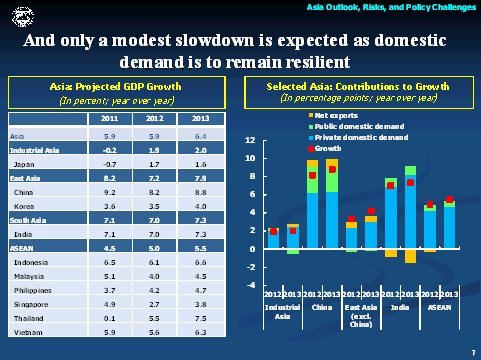
Against this background, we expect growth in the region to remain broadly in line with the 2011 outcome. While growth prospects for advanced economies continue to be critical for Asia’s overall export dynamics, our forecasts also reflect the moderation of growth in China.
At the same time, solid fundamentals for domestic demand, such as relatively strong employment, should support growth. In addition, continued capital inflows would spur private investment and consumption across the region by boosting confidence and contributing to a loosening of financial conditions. Reconstruction spending and the easing of supply disruptions should provide a temporary boost to growth in Japan and Thailand, while greater public investment would further strengthen domestic demand in other major ASEAN economies.
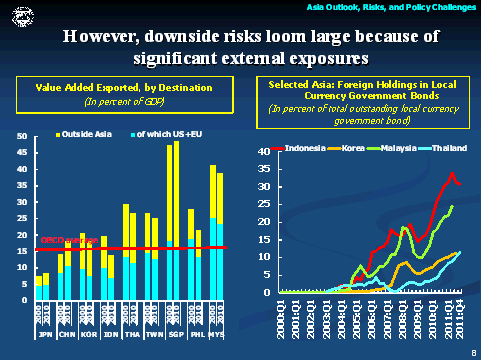
However, a high degree of trade and financial integration mean that Asia is exposed to the large downside risks surrounding the global recovery. On a value-added basis, for many smaller open Asian economies more than 1/3 of GDP is linked to demand outside Asia, and the bulk of this demand still comes from the traditional markets in the United States and Europe. A sharp fall in this demand would severely impact activity in Asia. Similarly, foreign participation in local financial markets has steadily increased over the past decade, reaching nearly 35 percent in the case of the Indonesian government bond market. This implies that the region has become more exposed to risks stemming from volatile capital flows. In this context, European banks have a large presence in Asia, both as direct lenders and through their role in wholesale funding of regional banks, including in Korea, Singapore and Malaysia. So far, however, there has been limited impact of the deleveraging process in the European Union on Asia as relatively healthy balance sheets have allowed large regional banks to act as a buffer against a credit supply shock. In fact, credit growth has continued at double digit rates in ASEAN countries, India and China.
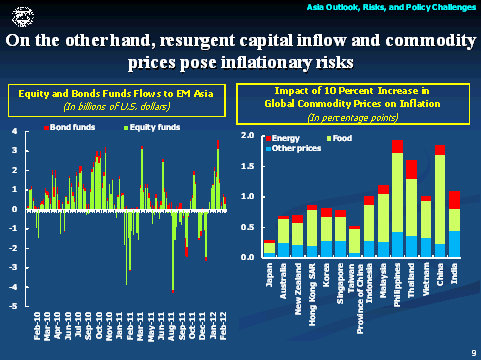
On the other hand, there are also upside risks for growth and inflation in Asia. If financial conditions in the euro zone were to normalize more rapidly than expected, this could drive a generalized decline in risk aversion, make carry trade more attractive and generate stronger and more persistent capital flows to Asia than currently built in our forecasts.
Geopolitical tensions could push oil prices sharply higher given low global inventories and spare capacity. And higher oil prices would add to inflation pressures, worsen growth prospects, and raise the cost of fuel-related subsidies in government budgets.
Allow me to say a few words about the outlook for Thailand. The Thai economy is closely integrated with the global economy. It has been adversely affected by the global financial crisis as growth dropped to - 2.3 percent in 2009. However, the Thai economy has also proven to be extremely resilient, bouncing back quickly from shocks. Indeed, the economy bounced back sharply in 2010, with growth reaching 7.8 percent.
Thailand is currently recovering from particularly challenging times last year, marked by natural disasters of historic magnitude. First the Japanese Tsunami affected manufacturing output via supply chain disruptions in the first quarter of 2011. As the economy started to recover, massive floods brought the manufacturing sector to a standstill. Total losses are estimated at about 3 percent of GDP. On a yearly basis, GDP growth shrank to a barely positive 0.1 percent in 2011. But the resiliency of the economy is already evident and we expect a sharp rebound in 2012. This is partly due to the measures introduced by the government (such as water management projects and minimun wage increase). Indeed, positive signs of a reconstruction and investment recovery are already underway with sharp improvements seen in high frequency indicators since last December. In fact, we expect a strong pick up in both domestic investment and consumption over the next two years, and this should support a V-shaped recovery with GDP growing by 5½ percent in 2012 and 7½ percent in 2013. The current policy mix of accommodative monetary policy and fiscal stimulus will, in our view, provide welcome support to domestic demand in the near term. But it is important to remain vigilant given that global risks are very volatile in today’s environment. And looking to the medium-term, a gradual unwinding is called for, assuming the global economic situation continues to normalize. We welcome the emphasis being placed on increasing productivity and making growth more inclusive. The effectiveness of policy measures needs to be carefully monitored to ensure that their objectives are achieved in an efficient manner.
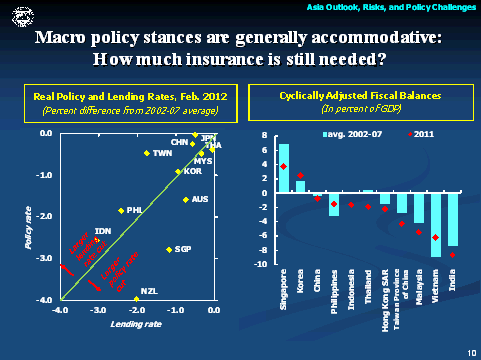
What are the main policy challenges for countries in Asia in more broadly? Against the backdrop of a still highly uncertain environment, policymakers face the difficult task of calibrating the amount of insurance needed to support stable, non inflationary growth.
On one hand, severe downside risks are still looming, and policymakers need to remain vigilant as signs of renewed deterioration in external conditions may require easing policies in those countries with the requisite policy space.
But with acute financial tensions receding earlier this year and signs that the slowdown is bottoming out in most of Asia in the first quarter, policymakers in the region should also stand ready to return to more neutral macro policies. Of course, the balance of risks and the need for switching gears quickly differs from country to country. Economies with greater exposure to downside risks and those closer to neutral monetary policy stances could afford to pause longer, but others with more accommodative conditions, stickier core inflation, and more buoyant credit growth may need a faster return to more neutral policy stances. The thrust of fiscal policies should be to rebuild space and reorient spending towards faster economic rebalancing.
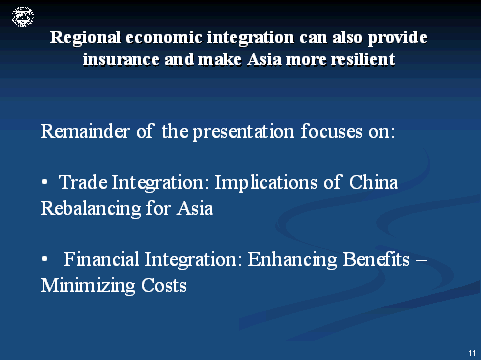
In the remainder of my presentation, I would like to focus on the role economic integration can play in making Thailand and other Asian economies more resilient. With China having been the dominant force in changing regional patterns of trade over the last decade, I will focus first on the potential impact of economic rebalancing there on the rest of Asia. Finally, I will briefly review the state of financial integration in Asia, and the potential benefits from further regional financial integration.
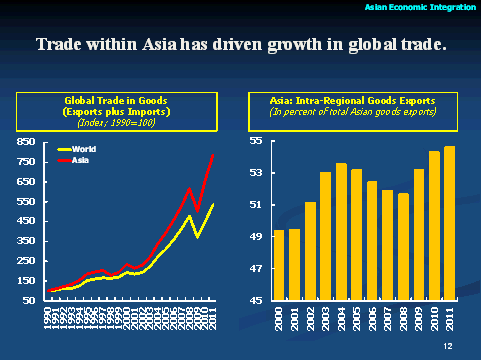
The most striking trend in Asia’s rise as the world’s leading source of exports has been the growth in intraregional trade. While global trade and Asia’s trade with economies outside the region have doubled since 2000, intra-Asian trade has tripled, and regional trade involving emerging Asia, in particular, has increased even faster. The bulk of that increase was driven by exports of intermediate goods.
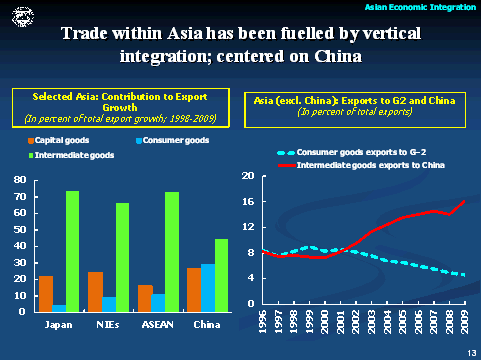
Asian economies increasingly have formed a supply network, with China taking the role of an assembly hub for final goods exports, notably consumer goods. For Asia, excluding China, the share of intermediate goods exports to China in total exports has doubled over the last decade, whereas the share of direct consumer goods exports to the United States and euro area has steadily declined. A closer look at vertical integration of exports between country pairs in Asia underscores the profound role of China in regional trade. Based on direct and indirect trade flows for intermediate goods, incorporating data from Asian input-output tables, we estimate that China ultimately accounts for about 50 percent of all intra-regional trade flows in imported inputs in Asia, more than double its share in 1995.
Korea has the closest link to China. It directly exports nearly 40 percent of its intermediate goods exports to China, four times its exports to Japan, its second most important export destination of intermediate goods. In addition, China’s share has increased in the intermediate goods exports of the ASEAN-5 economies. At the beginning of the 2000s, Japan was, by a wide margin, the most important destination of intermediate goods exports, accounting for an average 20 percent of direct exports from these countries. A decade later, Japan’s share has fallen to an average 15 percent. By contrast, China’s share more than tripled over the same period from about 4 percent to 14 percent.
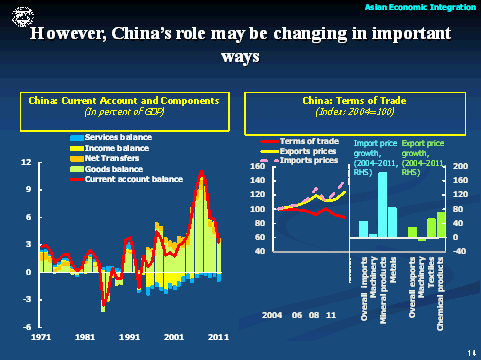
However, China’s role as a regional trade hub is changing in important ways. China’s current account surplus has declined from a pre-crisis peak of over 10 percent of GDP in 2007 to around 3 percent of GDP in 2011. The compression in the trade balance accounts for most of the decline. It appears increasingly likely that persistent forces are weighing on China’s trade surplus. Import prices are growing faster than export prices, and there is a sustained strength in imports, particularly of commodities and capital goods. Robust imports in turn are linked to strong investment demand, which raises the concern that new domestic imbalances may be growing, even as the external imbalances retreat. At the same time, China’s share of global exports is already above levels at which other export-oriented economies such as Japan and Korea, began to experience a waning ability to gain market share. Although China may continue to increase its export market share, particularly as its export basket rotates toward higher-end manufacturing, the pace at which this would occur may well moderate in the coming years.
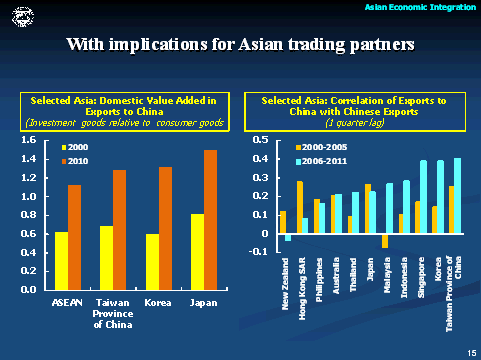
Which economies in Asia will benefit from more domestic-demand led growth in China? It is important to distinguish between investment and consumption-led growth, as only the latter would be consistent with sustained rebalancing. And in China, demand for investment goods has risen more sharply than demand for consumer goods, generally by a ratio of 2:1 The traditional capital goods exporters in Asia, Japan and Korea, have particularly benefited from China’s investment demand. However, high investment ratios in China may not be sustainable from a domestic perspective, and they may also fall in the event China’s export growth were set to slow permanently, given the close relationship between investment and exports.
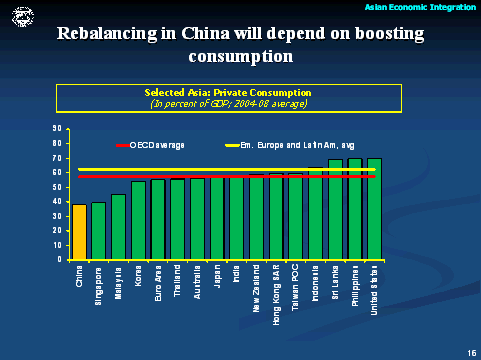
Were China to rebalance through consumption-led growth, ASEAN economies appear well positioned to benefit, given their comparative advantage relative to other exporters of consumer goods to China.. However, the benefits for regional trading partners may be small or even diminish over time. First, despite rapid growth, China’s role as an importer of consumer goods is still marginal, as it accounts for only 2 percent of global consumer goods imports. Second, its share in global consumer goods imports has risen less since 1995 than its share in global consumption. In other words, Chinese consumers have turned increasingly toward domestic products.
How would potentially slowing export growth in China affect the rest of Asia? As a result of the greater vertical trade integration that I described before, the correlation between Asian economies’ exports to China and Chinese exports has increased over the last decade. Estimates suggest that if Chinese export growth declines by1 percentage point then this would reduce the growth of other Asian economies’s exports to China by about 2/3 of a percentage point. This impact would fall on exporters of manufacturing goods (and not just on exporters of raw materials and commodities) because Chinese exports are the dominant driver of Asian manufacturing exports to China, rather than Chinese domestic demand.
Altogether, the decline in China’s trade surplus appears to be driven by the emergence of new domestic imbalances. As a result, Asian trading partners that have benefitted from investment-led growth in China may face growing headwinds to their exports. Given the importance of vertical supply chain links with China, they would also be hurt if China’s exports were to slow. By contrast, increasing direct and indirect access to the Chinese consumer good markets could offer lasting benefits for Asian trading partners.
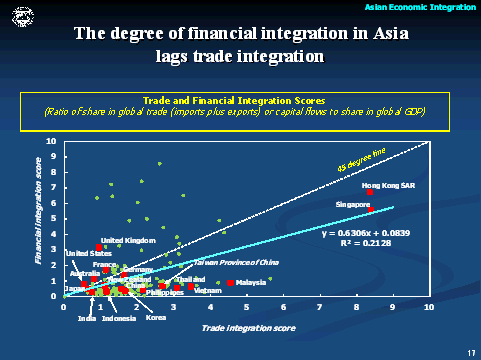
Measured against their high degree of integration with the global trading system, Asian economies’ degree of financial integration seems low. Typically, a country’s degree of financial integration, measured here by its share in global cross-border capital flows relative to its share in global GDP, tends to increase with its degree of trade integration, as measured by its share in global exports and imports relative to its share in global GDP. However, compared with the world, most Asian economies’ rapid expansion into global trade has not been matched by their role in international finance. This is true especially for the emerging economies of South East Asia, including Malaysia, Thailand, the Philippines, and Indonesia, the group of countries for which the main channel of financial integration is through FDI flows as opposed to portfolio investment or banking flows.
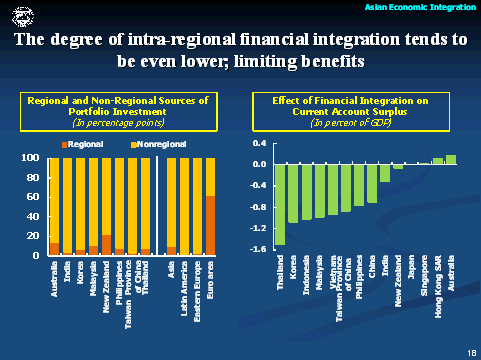
Having said that, cross-border portfolio investment, foreign direct investment (FDI) flows and banking activities have been rising in Asia, roughly doubling in dollar terms over last the last decade, except for a sharp decline during the global financial crisis of 2008–09. Relative to GDP, cross-border financial positions in Asia are comparable to other emerging economies of Latin America and Eastern Europe, but have remained substantially smaller than in the euro area, the group of advanced economies that are the most financially integrated. However, cross-border portfolio investment in Asia is predominantly interregional, that is it takes place mainly with advanced economies outside Asia, especially after adjusting for the role of Hong Kong SAR and Singapore in intermediating inflows from outside the region.
But greater regional financial integration could offer significant benefits. First, by deepening and diversifying countries’ overall degree of financial integration, more regional integration would afford countries a wider range of instruments and financial assets to obtain insurance against shocks and smooth consumption. Second, deeper financial integration with better access of consumers and investors to financial services would also strengthen domestic demand in the region and support economic rebalancing. IMF staff estimates suggest that if the degree of financial integration in Asia were to be at the global norm, on average across emerging Asia, the region’s current account surplus would be reduced by around 1 percent of GDP.
A number of measures can help further financial integration and support rebalancing. For example, inducing more competition in banking systems can increase access to credit and stimulate consumption and investment. In a similar vein, increasing liquidity and foreign participation in local currency bond markets could lower yields. Moreover, facilitating the transfer of financial know-how can foster financial innovation and lessen the motives for precautionary savings.
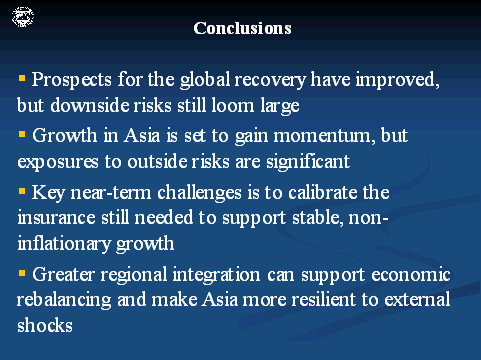
In sum, let me say that while prospects for the global recovery have improved in recent weeks, significant risks remain. Growth in Asia is also set to regain momentum, but policy makers face difficult challenges as the balance of risks remains highly uncertain and volatile. Providing the right amount of insurance in support of stable growth is not only the key near-term challenge. Reforms to enable countries to fully benefit from greater regional trade and financial integration can also play an important role in making Asia more resilient to external shocks. The ASEAN Economic Community which aims to go beyond mere trade integration towards building common markets with free flow of goods, factors, and services, could provide new impulses in this regard.
IMF EXTERNAL RELATIONS DEPARTMENT
| Public Affairs | Media Relations | |||
|---|---|---|---|---|
| E-mail: | publicaffairs@imf.org | E-mail: | media@imf.org | |
| Fax: | 202-623-6220 | Phone: | 202-623-7100 | |


